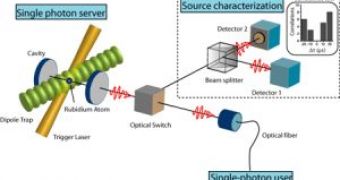When a light bulb is turned on, each second 10 to the power of 15 visible photons shed light in the room.
Now a team led by Professor Gerhard Rempe at the Max Planck Institute of Quantum Optics in Garching near Munich, Germany, has developed a single-photon server based on a single neutral atom, crucial for future quantum experiments with single photons.
The novel quantum information domain is going to employ quantum mechanics to compute some operations much more efficiently than classical computers.
One trapped atom can emit just one photon at a time, by applying a laser pulse. By locating the single atom between two highly reflective mirrors (a "cavity"), all of these photons are headed in the same direction.
These photons are of a very high quality, their energy amount is almost constant and the traits of the photons can be controlled, properties required by quantum computation.
On the other hand, up to now, it was not possible to trap a neutral atom in a cavity and at the same time generate single photons for a sufficiently long time to make practical usage of the photons.
In 2005, Rempe's team could rise the trapping times of single atoms in a cavity by employing three-dimensional cavity cooling.
Now, the researchers can combine cavity cooling with single photon generation, achieving the performance that a single atom can expel up to 300,000 photons. In the new system, the time of the atom availability is much longer than that necessary to cool and trap the atom.
This system can thus work with a large duty cycle, operating as a single-photon server, by employing a magneto-optical trap to get ultracold Rubidium atoms trapped inside the cavity in the vacuum chamber.
When a laser beam is applied from the side, a stream of single photons is emitted from the cavity, and between two single photon emissions the atom is cooled, thus it will not leave the trap.
Quantum information is one step closer to single-photon server operating.

 14 DAY TRIAL //
14 DAY TRIAL //